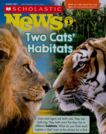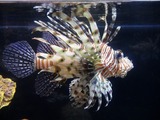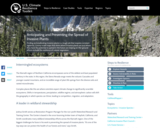
This is a lesson intended to help kindergarten students connect animal habitats to how those animals meet their need for water, food, shelter, and space.

This is a lesson intended to help kindergarten students connect animal habitats to how those animals meet their need for water, food, shelter, and space.

This lesson will help students explain animal habitats. Students will use the drawing tool in Pages to complete two pictures of animal habitats.Image-By me, Brooke Lee

This lesson takes students through 3 iPad apps to explore and explain animal habitats. Students will use the drawing tool in Pages to complete two pictures of animal habitats, use Keynote to follow links to San Diego zoo cameras and record their own audio describing the exhibits, and finally use iMovie to record themselves in their favorite animal habitat!*The thumbnail image was taken by Lindsay Stahl at the Living Planet Aquarium

This project is designed to help students create a short documentary film using the information they gathered to create an animal report. It can be used after writing an animal report or can be adapted to be used as the actual animal report. It can be designed to appear as a documentary series with all students having the same title opening, or be completely standalone. Students will be learning to find creative commons photos and videos to use in their film. They will create their film using iMovie on their iPads. Brown-Throated three-toed sloth female face.jpg- Wikimedia Commons

Learn about the structure and function of living organisms by drawing an imaginary animal in the Take the Stage game show, ANIMAL SURVIVAL! Viewers become contestants on a game show and are challenged to draw an imaginary animal that could live and survive in either the desert, ocean, or the arctic tundra. When drawing the imaginary animal, the contestants write out two distinct structures and a function for each of the structures that help it survive. Learning Objective: Compare the structures and functions of different species that help them live and survive in a specific environment.

This in an Animal Unit designed for third grade science curriculum. It includes information on animal life cycles, inherited traits, and habitats.

This informational text explains that while both the Arctic and Antarctica are cold, Antarctica is much colder and drier - a polar desert. The text is written at a grade four through grade five reading level. This is a PDF containing the informational text and a glossary.

This article describes a discovery of moss and ostracod fossils that led to a better understanding of Antarctica's climate history.

This informational text explains that while both the Arctic and Antarctica are cold, Antarctica is much colder and drier - a polar desert. The text is written at a grade two through grade three reading level. This version is a full-color PDF that can be printed, cut and folded to form a book. Each book contains color photographs and illustrations.

Finding and eradicating invasive plants is a tough job that requires constant vigilance. County-scale maps that show where invasive plants are and where they have the potential to spread in the future are helping on-the-ground efforts to build the resilience of natural vegetation.

See the many birds that spend their summer in the Arctic in this video segment from Nature.

This video segment from Wild Europe: "Wild Arctic" explores the struggle for survival in one of Earth's most extreme environments.

This video segment adapted from NOVA features a variety of scientific perspectives on the age old question, "Are we alone in the universe?" Animations make vivid the improbability that we could intercept a radio wave signaling extra terrestrial intelligence.

This video segment explores the benefits and pitfalls of cloning as a means of reproduction. From Evolution: "Why Sex?"

This Readers Theater script includes parts for 8-9 students. It is based on the Feature Story, At Home in the Cold and discusses various adaptations that allow animals to survive in the cold oceans of the Arctic and Antarctica. The script was written for students in grades 4-5.

This informational text explores adaptations that allow penguins, whales, walruses, seals, and fish to live in the cold water of the Arctic and Southern Oceans. The text is at reading level appropriate for students in second through third grade. It is a PDF file that contains text as well as a glossary.

This informational text explores adaptations that allow penguins, whales, walruses, seals, and fish to live in the cold water of the Arctic and Southern Oceans. The text is at reading level appropriate for students in fourth through fifth grade. It is a PDF file that contains the text as well as a glossary.

In this feature, adapted from Interactive NOVA: "Earth," students explore the relationship between oxygen concentration and the well-being of various organisms by simulating a change in oxygen levels and observing what happens.

This informational text explains the colorful phenomenon known as the northern lights (aurora borealis) and the southern lights (aurora australis). Students explore the cause of the aurora. The text is written at a grade four through five reading level. This is a PDF containing the informational text and a glossary.

The axolotl is a Mexican salamander with an incredible ability: Cut its leg off, and the limb will grow right back! How it does this and why humans can't is still a bit of a mystery. Researchers like Susan Bryant of UC Irvine are studying these amphibians to understand the underlying mechanisms for their miraculous regenerative powers.